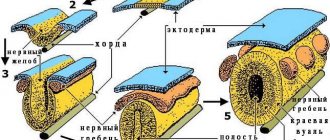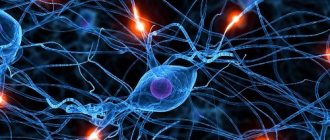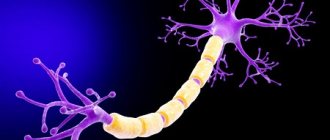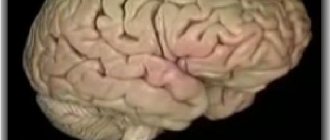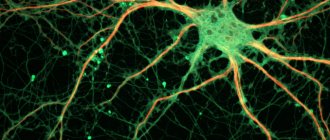Anatomy of myelin in the structure of a nerve
The main cell of the nervous system is the neuron.
The body of the neuron is called the soma. There is a core inside it. The body of the neuron is surrounded by short processes called dendrites. They are responsible for communication with other neurons. One long process, the axon, extends from the soma. It carries impulses from the neuron to other cells. Most often, at the end it connects with the dendrites of other nerve cells. The entire surface of the axon is covered by the myelin sheath, which is a process of the Schwann cell, devoid of cytoplasm. Essentially, it is several layers of cell membrane wrapped around the axon.
Schwann cells enveloping the axon are separated by nodes of Ranvier, which lack myelin.
Features of neuroglial cells
As we have already said, the myelin sheath of dendrites and axons is formed by special structures characterized by a low degree of permeability to sodium and calcium ions, and therefore having only resting potentials (they cannot conduct nerve impulses and perform electrical insulating functions).
These structures are called glial cells. These include:
- oligodendrocytes;
- fibrous astrocytes;
- ependymal cells;
- plasmatic astrocytes.
All of them are formed from the outer layer of the embryo - ectoderm and have a common name - macroglia. Glia of the sympathetic, parasympathetic and somatic nerves are represented by Schwann cells (neurolemmocytes).
Functions
The main functions of the myelin sheath are:
- axon isolation;
- acceleration of impulse conduction;
- energy savings by maintaining ion flows;
- nerve fiber support;
- axon nutrition.
How pulses work
Nerve cells are isolated due to their membrane, but are still interconnected. The areas where cells touch are called synapses. It is where the axon of one cell and the soma or dendrite of another meet.
An electrical impulse can be transmitted within a single cell or from neuron to neuron. This is a complex electrochemical process that is based on the movement of ions through the membrane of the nerve cell.
In a calm state, only potassium ions enter the neuron, and sodium ions remain outside. At the moment of excitement they begin to change places. The axon is positively charged from within. Then sodium stops flowing through the membrane, but the outflow of potassium does not stop.
The change in voltage due to the movement of potassium and sodium ions is called the "action potential". It spreads slowly, but the myelin sheath that envelops the axon speeds up this process by preventing the outflow and influx of potassium and sodium ions from the axon body.
Passing through the node of Ranvier, the impulse jumps from one part of the axon to another, which allows it to move faster.
Once the action potential crosses the break in the myelin, the impulse stops and the resting state returns.
This method of energy transfer is characteristic of the central nervous system. As for the autonomic nervous system, it often contains axons covered with little or no myelin. There are no jumps between Schwann cells, and the impulse travels much more slowly.
Prevention of multiple sclerosis
Since at present it has not been possible to specify the true causes of multiple sclerosis, prevention of the disease comes down to simple recommendations that everyone can follow.
Quitting alcohol and smoking
Bad habits, especially alcohol and smoking, cause regular irritation of the cells of the nervous system. Carcinogens accumulate in soft tissues, vasoconstriction occurs, which complicates and accelerates pathogenic processes. Giving up bad habits will preserve your immunity and reduce the risk of disease by 2 times.
Important! In adolescence, regular smoking leads to the destruction of an immature immune system, increasing the risk of autoimmune diseases.
How to cope with stress and physical fatigue?
To control stress and relieve accumulated fatigue, you should learn to manage your psychological state. You can do this using the following tips:
Try to complete all tasks to the end. When planning things for tomorrow, you don’t need to set super-tasks for yourself. It’s better that you do the two most important things than not finish the 10 planned things at once. The feeling of achieving goals can reduce stress.- Use relaxation or meditation more often. When stressed, it is recommended to lie down on a flat surface, turn on calm music or special audio recordings that teach stress relief.
- Do what you love. Try to direct bad thoughts in a different direction. To do this, you can switch to your favorite hobby, for example, watching a good movie, knitting, reading a book with a good plot.
- Don't forget to take walks in the fresh air and be sure to communicate with people close to you.
Diet and balanced nutrition
- Proper nutrition should include a sufficient amount of clean water, as well as green tea, which is useful in this case.
- Food should be taken 3 times a day in large portions, or up to 5 times a day in small portions.
- It is not recommended to include foods high in fat in your diet. It is better to consume more fiber, which helps prevent diabetes and cardiovascular disease.
- Be sure to saturate your body with vitamins, minerals and nutrients.
- For multiple sclerosis, the Ashton Embry diet is popular. He advises excluding proteins, dairy products, cereals and legumes from the diet. Healthy foods, in his opinion, include chicken breast, fish, vegetables (except potatoes), gluten-free cereals and nuts.
Watch a video about nutrition for multiple sclerosis:
Active lifestyle
Regular physical activity on the body will help prevent the diagnosis of multiple sclerosis. To do this, you need to choose a set of simple and easy-to-follow exercises that normalize blood circulation, increase muscle tone and promote a cheerful mood. If necessary, you need to lose extra pounds and bring your weight back to normal.
Attention! Physical activity should not be exhausting, leading to severe fatigue.
Where to start prevention?
Initially, you should follow a few simple rules, namely:
- Avoid infectious diseases.
- Help improve immunity in every possible way.
- Monitor your diet carefully.
- Lead a healthy lifestyle.
- Don't forget about rest and massage.
Useful exercises to prevent illness

Check out some examples of physical therapy exercises that are designed to prevent multiple sclerosis:
- Sitting on a chair, place your hands on your waist. Next, you need to simultaneously move your right arm and left leg to the side. Then vice versa. And so 4 times.
- Sitting on a chair, bend your elbows. You should rotate the brushes on different sides in 4 circles 3 times.
- Lying on your back, place your hands under your head and bend your legs at the knees. Raise and lower your pelvis 6 times.
Watch a video about physical therapy for multiple sclerosis:
The benefits of yoga and swimming
Autoimmune diseases are often accompanied by profound fatigue in the body. Yoga in this case promotes relaxation, rest, accumulation of vitality and energy. To perform yoga, equipment such as rollers, bricks, and ropes is used. It is best to consult with a trainer so that he can select an individual exercise program.
Swimming in water at a comfortable temperature is also beneficial. You can include special water gymnastics in your pool exercises, which strengthen the body and relieve nervous tension.
Compound
The myelin layer consists of two layers of lipids and three layers of protein. There are much more lipids in it (70-75%):
- phospholipids (up to 50%);
- cholesterol (25%);
- glactocerebroside (20%), etc.
The high fat content causes the myelin sheath to be white, which is why the neurons covered by it are called “white matter.”
Protein layers are thinner than lipid layers. The protein content in myelin is 25-30%:
- proteolipid (35-50%);
- myelin basic protein (30%);
- Wolfgram proteins (20%).
There are simple and complex proteins of nervous tissue.
The role of lipids in the structure of the shell
Lipids play a key role in the structure of the pulp membrane. They are the structural material of nervous tissue and protect the axon from energy loss and ion flows. Lipid molecules have the ability to restore brain tissue after damage. Myelin lipids are responsible for adaptation of the mature nervous system. They act as hormone receptors and communicate between cells.
The role of proteins
Protein molecules are of no small importance in the structure of the myelin layer. They, along with lipids, act as the building material of nervous tissue. Their main task is to transport nutrients into the axon. They also decipher signals entering the nerve cell and speed up reactions in it. Participation in metabolism is an important function of the myelin sheath protein molecules.
The adult brain never stops developing
When we learn a new skill, whether it's programming, playing chess, roller skating, or dancing, we unknowingly change our brains.
Scientific research has shown that the brain is incredibly plastic, meaning that it is not completely formed at age 25 and does not remain unchanged for the rest of life. While certain things (like language) are much easier for children than for adults, there is ample evidence that the neural network of the adult brain can also change.
But how does this happen? To perform a certain task, we need to activate certain parts of the brain. The human brain coordinates a complex set of reactions, including motor function, processing of visual and auditory information, speech, and more. At first, we may get confused and forget some things and words, but practice helps us cope with the task better, feeling more natural and comfortable.
Constant learning helps the brain optimize the execution of a set of coordinated actions through the process of myelination - the formation of a layer of myelin around the axons of nerve fibers.
Myelination defects
Destruction of the myelin layer of the nervous system is a very serious pathology, due to which the transmission of nerve impulses is disrupted. It causes dangerous diseases, often incompatible with life. There are two types of factors influencing the occurrence of demyelination:
- genetic predisposition to myelin destruction;
- impact on myelin of internal or external factors.
- Demyelization is divided into three types:
- acute;
- relapsing;
- acute monophasic.
Why does destruction occur?
The most common causes of destruction of the pulp membrane are:
- rheumatic diseases;
- significant predominance of proteins and fats in the diet;
- genetic predisposition;
- bacterial infections;
- heavy metal poisoning;
- tumors and metastases;
- prolonged severe stress;
- bad ecology;
- pathologies of the immune system;
- long-term use of antipsychotics.
Diseases due to demyelination
Demyelinating diseases of the central nervous system:
- Canavan disease is a genetic disorder that occurs early in life. It is characterized by blindness, problems with swallowing and eating, and motor and developmental disorders. Epilepsy, macrocephaly and muscle hypotonia are also consequences of this disease.
- Binswanger's disease. Most often caused by arterial hypertension. Patients are expected to have thinking disorders, dementia, as well as walking and pelvic organ dysfunction.
- Multiple sclerosis. May cause damage to several parts of the central nervous system. It is accompanied by paresis, paralysis, convulsions and impaired motor skills. Also, symptoms of multiple sclerosis include behavioral disorders, weakening of the facial muscles and vocal cords, and sensory disturbances. Vision is impaired, the perception of color and brightness changes. Multiple sclerosis is also characterized by disorders of the pelvic organs and dystrophy of the brain stem, cerebellum and cranial nerves.
- Devic's disease is demyelination in the optic nerve and spinal cord. The disease is characterized by disturbances in coordination, sensitivity and functions of the pelvic organs. It is characterized by severe visual impairment and even blindness. The clinical picture also includes paresis, muscle weakness and autonomic dysfunction.
- Osmotic demyelination syndrome . Occurs due to a lack of sodium in the cells. Symptoms include convulsions, personality disorders, loss of consciousness, even coma and death. The consequences of the disease are cerebral edema, hypothalamic infarction and brainstem herniation.
- Myelopathies are various dystrophic changes in the spinal cord. They are characterized by muscle disorders, sensory disorders and pelvic organ dysfunction.
- Leukoencephalopathy is the destruction of the myelin sheath in the subcortex of the brain. Patients suffer from constant headaches and epileptic seizures. Impairments in vision, speech, coordination and walking are also observed. Sensitivity decreases, personality and consciousness disorders are observed, and dementia progresses.
- Leukodystrophy is a genetic metabolic disorder that causes the destruction of myelin. The course of the disease is accompanied by muscle and movement disorders, paralysis, visual and hearing impairment, and progressive dementia.
Demyelinating diseases of the peripheral nervous system:
- Guillain-Barré syndrome is an acute inflammatory demyelination. It is characterized by muscle and movement disorders, respiratory failure, partial or complete absence of tendon reflexes. Patients suffer from heart disease, disruption of the digestive system and pelvic organs. Paresis and sensory disturbances are also signs of this syndrome.
- Neural amyotrophy of Charcot-Marie-Tooth is a hereditary pathology of the myelin sheath. It is distinguished by sensory disturbances, limb dystrophy, spinal deformity and tremor.
These are only some of the diseases that arise due to the destruction of the myelin layer. The symptoms are similar in most cases. An accurate diagnosis can be made only after a computer or magnetic resonance imaging scan. An important role in making a diagnosis is played by the level of qualifications of the doctor.
Practice, nerve activity and myelin synthesis
We have found that the myelin sheath is an important component of the brain structure, which ensures faster transmission of nerve impulses. But is there any way to “grow” myelin around axons?
It is important to understand that the process of myelination occurs naturally, mainly during childhood. Children are “myelin generators” who absorb information about the world around them like sponges. With age, this ability decreases, but does not disappear completely, that is, in adults, the process of myelination also occurs, only more slowly, and more effort is required to “build up” myelin.
Children are “myelin generators” who absorb information about the world around them like sponges.
Scientists believe that two types of glial cells in the brain play a role in creating new myelin. The first type is astrocytes, which monitor the activity of the axons of nerve cells. A large number of repeated signals from a particular axon prompt the astrocyte to release chemicals that stimulate a second type of cell, oligodendrocytes, to produce myelin, which envelops the axon.
Therefore, constant practice, whether writing articles for a blog, learning a foreign language, origami, knitting or any other mastered skill, helps to create new patterns of transmission of electrical signals between neurons. Over time, this triggers the process of myelination of the corresponding axons and increases the strength and speed of signal transmission.
Principles of treatment of shell defects
Diseases associated with the destruction of the pulp membrane are very difficult to treat. Therapy is aimed mainly at relieving symptoms and stopping destruction processes. The earlier the disease is diagnosed, the greater the chances of stopping its progression.
Possibilities of myelin restoration
Thanks to timely treatment, the process of myelin restoration can be started. However, the new myelin sheath will not perform its functions as well. In addition, the disease may enter a chronic stage, and the symptoms will persist, only slightly smoothing out. But even minor remyelination can stop the course of the disease and partially restore lost functions.
Modern drugs aimed at myelin regeneration are more effective, but are very expensive.
Therapy
The following drugs and procedures are used to treat diseases caused by the destruction of the myelin sheath:
- beta interferons (stop the course of the disease, reduce the risk of relapses and disability);
- immunomodulators (affect the activity of the immune system);
- muscle relaxants (help restore motor functions);
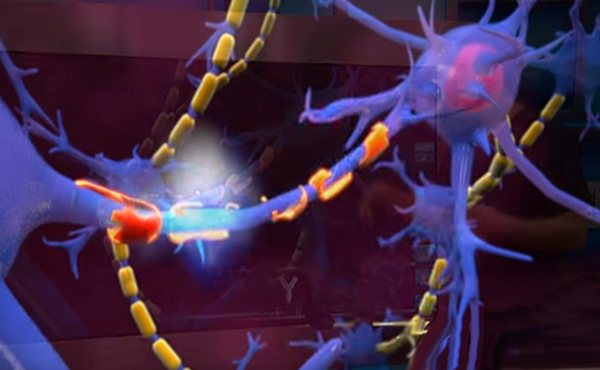
- nootropics (restore conductive activity);
- anti-inflammatory (relieve the inflammatory process that caused the destruction of myelin);
- neuroprotectors (prevent damage to brain neurons);
- painkillers and anticonvulsants;
- vitamins and antidepressants;
- cerebrospinal fluid filtration (a procedure aimed at cleansing cerebrospinal fluid).
Disease forecast
Currently, the treatment of demyelination does not give a 100% result, but scientists are actively developing drugs aimed at restoring the pulp membrane. Research is carried out in the following areas:
- Stimulation of oligodendrocytes . These are the cells that produce myelin. They do not work in a body affected by demyelination. Artificial stimulation of these cells will help start the process of restoring damaged areas of the myelin sheath.
- Stem cell stimulation . Stem cells can develop into full-fledged tissue. There is a possibility that they can also fill the pulpy shell.
- Regeneration of the blood-brain barrier . During demyelination, this barrier is destroyed and allows lymphocytes to negatively affect myelin. Its restoration protects the myelin layer from attack by the immune system.
Perhaps soon diseases associated with the destruction of myelin will no longer be incurable.
Schwann cells and their features
The myelin sheath of the nerves of the peripheral system is formed by neurolemmocytes (Schwann cells). Their distinctive feature is that they are able to form a protective sheath of only one axon, and cannot form processes, as is inherent in oligodendrocytes.
Between the Schwann cells, at a distance of 1-2 mm, there are areas devoid of myelin, the so-called nodes of Ranvier. Along them, electrical impulses are carried out spasmodically within the axon.
Lemmocytes are capable of repairing nerve fibers and also perform a trophic function. As a result of genetic aberrations, the cells of the membrane of lemmocytes begin uncontrolled mitotic division and growth, as a result of which tumors develop in various parts of the nervous system - schwannomas (neurinomas).

